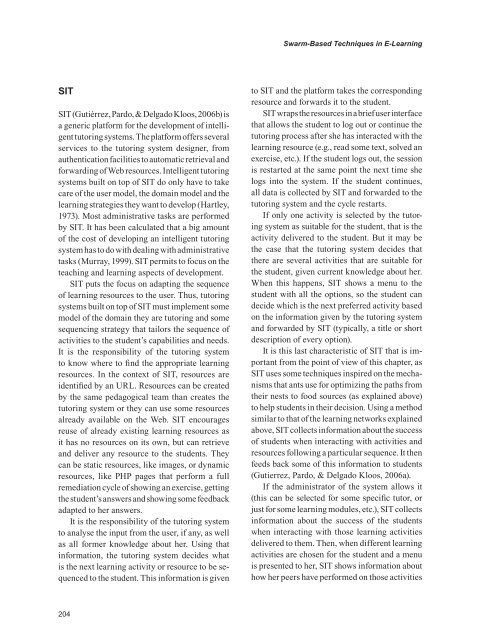Advances in E-learning-Experiences and Methodologies
You also want an ePaper? Increase the reach of your titles
YUMPU automatically turns print PDFs into web optimized ePapers that Google loves.
Swarm-Based Techniques <strong>in</strong> E-Learn<strong>in</strong>g<br />
sIt<br />
SIT (Gutiérrez, Pardo, & Delgado Kloos, 2006b) is<br />
a generic platform for the development of <strong>in</strong>telligent<br />
tutor<strong>in</strong>g systems. The platform offers several<br />
services to the tutor<strong>in</strong>g system designer, from<br />
authentication facilities to automatic retrieval <strong>and</strong><br />
forward<strong>in</strong>g of Web resources. Intelligent tutor<strong>in</strong>g<br />
systems built on top of SIT do only have to take<br />
care of the user model, the doma<strong>in</strong> model <strong>and</strong> the<br />
learn<strong>in</strong>g strategies they want to develop (Hartley,<br />
1973). Most adm<strong>in</strong>istrative tasks are performed<br />
by SIT. It has been calculated that a big amount<br />
of the cost of develop<strong>in</strong>g an <strong>in</strong>telligent tutor<strong>in</strong>g<br />
system has to do with deal<strong>in</strong>g with adm<strong>in</strong>istrative<br />
tasks (Murray, 1999). SIT permits to focus on the<br />
teach<strong>in</strong>g <strong>and</strong> learn<strong>in</strong>g aspects of development.<br />
SIT puts the focus on adapt<strong>in</strong>g the sequence<br />
of learn<strong>in</strong>g resources to the user. Thus, tutor<strong>in</strong>g<br />
systems built on top of SIT must implement some<br />
model of the doma<strong>in</strong> they are tutor<strong>in</strong>g <strong>and</strong> some<br />
sequenc<strong>in</strong>g strategy that tailors the sequence of<br />
activities to the student’s capabilities <strong>and</strong> needs.<br />
It is the responsibility of the tutor<strong>in</strong>g system<br />
to know where to f<strong>in</strong>d the appropriate learn<strong>in</strong>g<br />
resources. In the context of SIT, resources are<br />
identified by an URL. Resources can be created<br />
by the same pedagogical team than creates the<br />
tutor<strong>in</strong>g system or they can use some resources<br />
already available on the Web. SIT encourages<br />
reuse of already exist<strong>in</strong>g learn<strong>in</strong>g resources as<br />
it has no resources on its own, but can retrieve<br />
<strong>and</strong> deliver any resource to the students. They<br />
can be static resources, like images, or dynamic<br />
resources, like PHP pages that perform a full<br />
remediation cycle of show<strong>in</strong>g an exercise, gett<strong>in</strong>g<br />
the student’s answers <strong>and</strong> show<strong>in</strong>g some feedback<br />
adapted to her answers.<br />
It is the responsibility of the tutor<strong>in</strong>g system<br />
to analyse the <strong>in</strong>put from the user, if any, as well<br />
as all former knowledge about her. Us<strong>in</strong>g that<br />
<strong>in</strong>formation, the tutor<strong>in</strong>g system decides what<br />
is the next learn<strong>in</strong>g activity or resource to be sequenced<br />
to the student. This <strong>in</strong>formation is given<br />
to SIT <strong>and</strong> the platform takes the correspond<strong>in</strong>g<br />
resource <strong>and</strong> forwards it to the student.<br />
SIT wraps the resources <strong>in</strong> a brief user <strong>in</strong>terface<br />
that allows the student to log out or cont<strong>in</strong>ue the<br />
tutor<strong>in</strong>g process after she has <strong>in</strong>teracted with the<br />
learn<strong>in</strong>g resource (e.g., read some text, solved an<br />
exercise, etc.). If the student logs out, the session<br />
is restarted at the same po<strong>in</strong>t the next time she<br />
logs <strong>in</strong>to the system. If the student cont<strong>in</strong>ues,<br />
all data is collected by SIT <strong>and</strong> forwarded to the<br />
tutor<strong>in</strong>g system <strong>and</strong> the cycle restarts.<br />
If only one activity is selected by the tutor<strong>in</strong>g<br />
system as suitable for the student, that is the<br />
activity delivered to the student. But it may be<br />
the case that the tutor<strong>in</strong>g system decides that<br />
there are several activities that are suitable for<br />
the student, given current knowledge about her.<br />
When this happens, SIT shows a menu to the<br />
student with all the options, so the student can<br />
decide which is the next preferred activity based<br />
on the <strong>in</strong>formation given by the tutor<strong>in</strong>g system<br />
<strong>and</strong> forwarded by SIT (typically, a title or short<br />
description of every option).<br />
It is this last characteristic of SIT that is important<br />
from the po<strong>in</strong>t of view of this chapter, as<br />
SIT uses some techniques <strong>in</strong>spired on the mechanisms<br />
that ants use for optimiz<strong>in</strong>g the paths from<br />
their nests to food sources (as expla<strong>in</strong>ed above)<br />
to help students <strong>in</strong> their decision. Us<strong>in</strong>g a method<br />
similar to that of the learn<strong>in</strong>g networks expla<strong>in</strong>ed<br />
above, SIT collects <strong>in</strong>formation about the success<br />
of students when <strong>in</strong>teract<strong>in</strong>g with activities <strong>and</strong><br />
resources follow<strong>in</strong>g a particular sequence. It then<br />
feeds back some of this <strong>in</strong>formation to students<br />
(Gutierrez, Pardo, & Delgado Kloos, 2006a).<br />
If the adm<strong>in</strong>istrator of the system allows it<br />
(this can be selected for some specific tutor, or<br />
just for some learn<strong>in</strong>g modules, etc.), SIT collects<br />
<strong>in</strong>formation about the success of the students<br />
when <strong>in</strong>teract<strong>in</strong>g with those learn<strong>in</strong>g activities<br />
delivered to them. Then, when different learn<strong>in</strong>g<br />
activities are chosen for the student <strong>and</strong> a menu<br />
is presented to her, SIT shows <strong>in</strong>formation about<br />
how her peers have performed on those activities<br />
0


